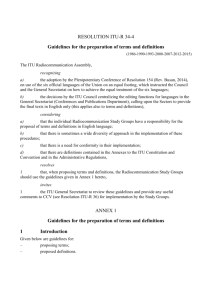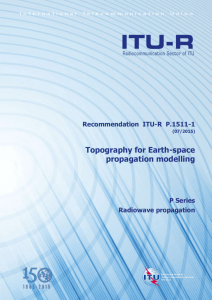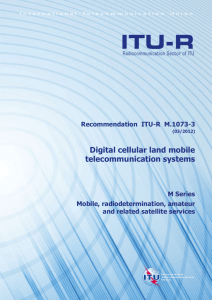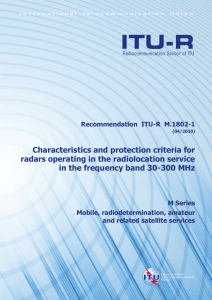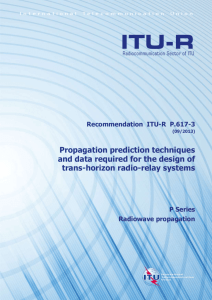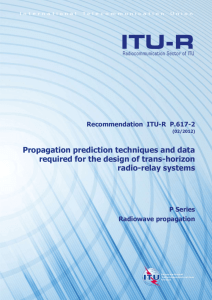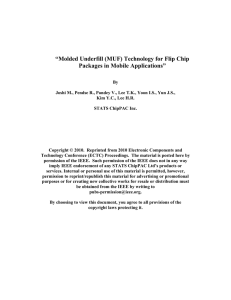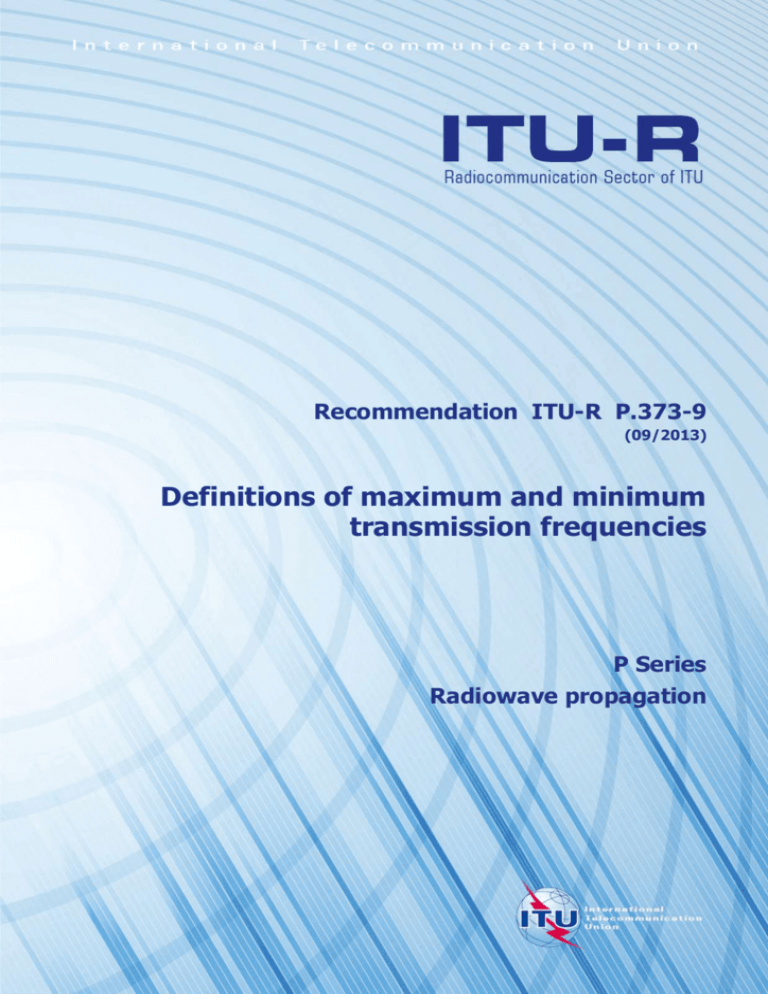
Recommendation ITU-R P.373-9
(09/2013)
Definitions of maximum and minimum
transmission frequencies
P Series
Radiowave propagation
ii
Rec. ITU-R P.373-9
Foreword
The role of the Radiocommunication Sector is to ensure the rational, equitable, efficient and economical use of the
radio-frequency spectrum by all radiocommunication services, including satellite services, and carry out studies without
limit of frequency range on the basis of which Recommendations are adopted.
The regulatory and policy functions of the Radiocommunication Sector are performed by World and Regional
Radiocommunication Conferences and Radiocommunication Assemblies supported by Study Groups.
Policy on Intellectual Property Right (IPR)
ITU-R policy on IPR is described in the Common Patent Policy for ITU-T/ITU-R/ISO/IEC referenced in Annex 1 of
Resolution ITU-R 1. Forms to be used for the submission of patent statements and licensing declarations by patent
holders are available from http://www.itu.int/ITU-R/go/patents/en where the Guidelines for Implementation of the
Common Patent Policy for ITU-T/ITU-R/ISO/IEC and the ITU-R patent information database can also be found.
Series of ITU-R Recommendations
(Also available online at http://www.itu.int/publ/R-REC/en)
Series
BO
BR
BS
BT
F
M
P
RA
RS
S
SA
SF
SM
SNG
TF
V
Title
Satellite delivery
Recording for production, archival and play-out; film for television
Broadcasting service (sound)
Broadcasting service (television)
Fixed service
Mobile, radiodetermination, amateur and related satellite services
Radiowave propagation
Radio astronomy
Remote sensing systems
Fixed-satellite service
Space applications and meteorology
Frequency sharing and coordination between fixed-satellite and fixed service systems
Spectrum management
Satellite news gathering
Time signals and frequency standards emissions
Vocabulary and related subjects
Note: This ITU-R Recommendation was approved in English under the procedure detailed in Resolution ITU-R 1.
Electronic Publication
Geneva, 2013
ITU 2013
All rights reserved. No part of this publication may be reproduced, by any means whatsoever, without written permission of ITU.
Rec. ITU-R P.373-9
1
RECOMMENDATION ITU-R P.373-9
Definitions of maximum and minimum transmission frequencies
(Question ITU-R 212/3)
(1959-1963-1966-1970-1974-1978-1982-1990-1995-2007-2013)
Scope
This Recommendation provides definitions of the maximum and minimum transmission frequencies. These
definitions are being employed in ITU-R Recommendations related to propagation prediction methods and
operational matters and they are also used by scientists and radiocommunication operators.
The ITU Radiocommunication Assembly,
considering
that prediction services, scientists and operators have different requirements for definitions of the
maximum and minimum transmission frequency,
recommends
1
that the following definitions should be used for maximum usable frequency (MUF):
operational MUF, is the highest frequency that would permit acceptable performance of a radio
circuit by signal propagation via the ionosphere between given terminals at a given time under
specified working conditions.
NOTE 1 – Acceptable performance may for example be quoted in terms of maximum error ratio or
required signal/noise ratio.
NOTE 2 – Specified working conditions may include such factors as antenna types, transmitter
power, class of emission and required performance;
basic MUF is the highest frequency by which a radiowave can propagate between given terminals,
on a specified occasion, by ionospheric refraction alone;
2
that the additional terms and extended descriptions, given in Annex 1, may also be used.
Annex 1
Additional definitions
Optimum working frequency (OWF) or Optimum traffic frequency (FOT): the lower decile of the
daily values of operational MUF at a given time over a specified period, usually a month. That is,
it is the frequency that is exceeded by the operational MUF during 90% of the specified period.
Highest probable frequency (HPF): the upper decile of the daily values of operational MUF at a
given time over a specified period, usually a month. That is, it is the frequency that is exceeded by
the operational MUF during 10% of the specified period.
2
Rec. ITU-R P.373-9
Lowest usable frequency (LUF): the lowest frequency that would permit acceptable performance of
a radio circuit by signal propagation via the ionosphere between given terminals at a given time
under specified working conditions.
NOTE 1 – Where the basic MUF is restricted to a particular ionospheric propagation mode, the values may
be quoted together with an indication of that mode (for example, 1E MUF, 2F2 MUF).
NOTE 2 – If the extraordinary component of the wave is involved, then this is noted (for example,
1F2 MUF(X)). Absence of a specific reference to the magnetoionic component implies that the quoted value
relates to the ordinary wave.
NOTE 3 – It is sometimes useful to quote the ground range for which the basic MUF applies. This is
indicated in kilometres following the indication of the mode type (for example, 1F2 (4 000) MUF(X)).
NOTE 4 – Where the basic MUF term refers to the median value, or some other percentile (x), of a month or
season, this may be indicated by giving the percentile value following the term (for example, MUF(50), for a
median value).
__________

